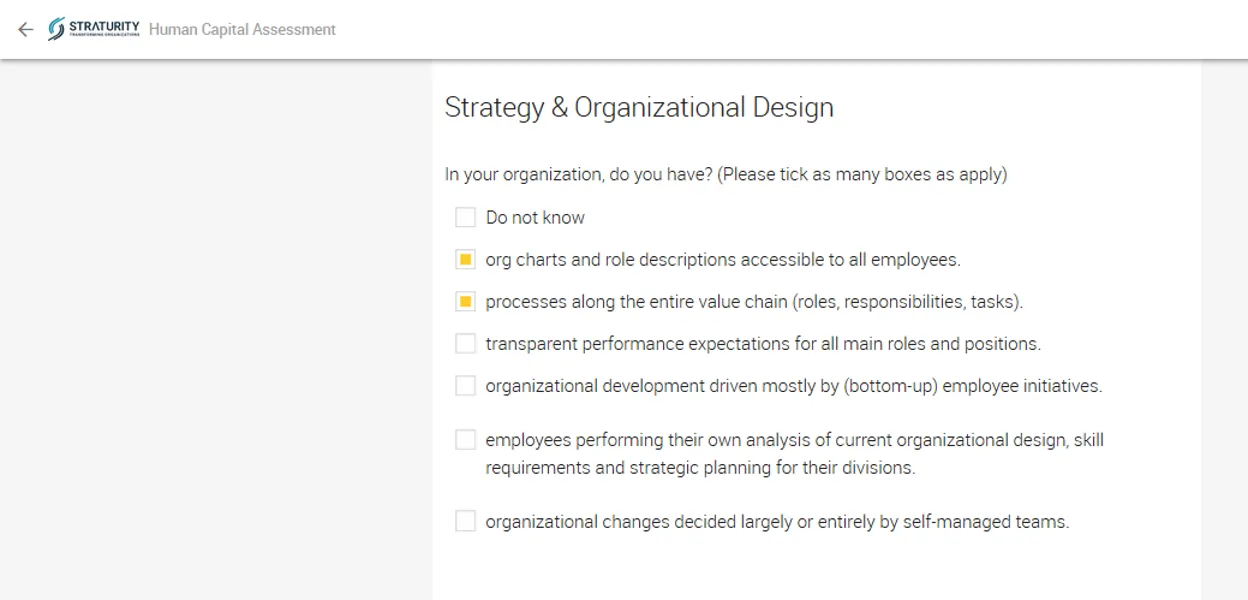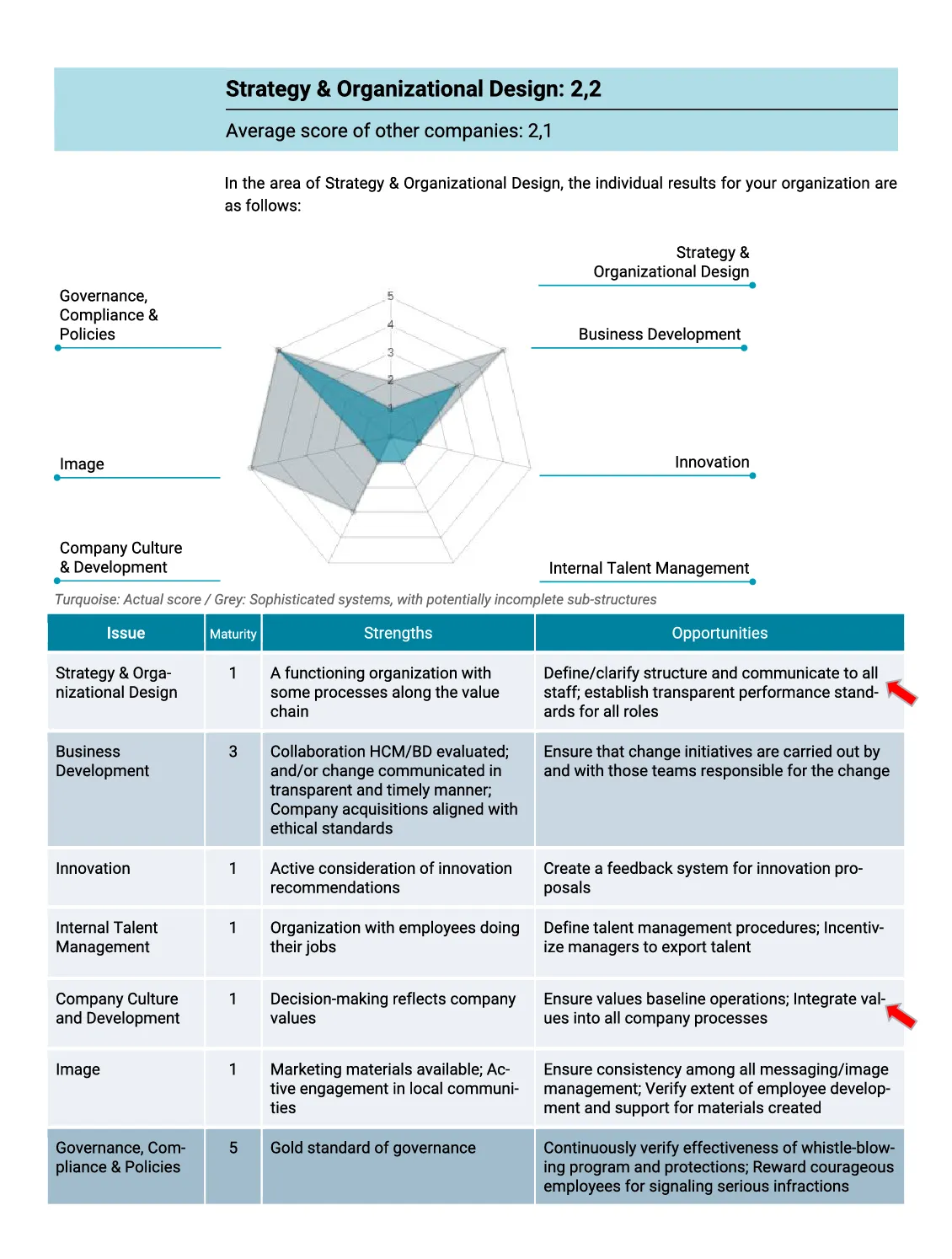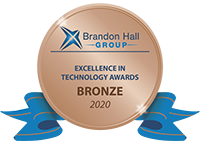The Maturity Model
Levels 1-3 build on each other and are important to support consistent quality in human and talent management. Levels 4 and 5 build further on that basis and show a high degree of sophistication and effort. Should you receive a lower than expected maturity level in some areas despite having sophisticated systems, it may be that the processes or transparency necessary for sustainability are not sufficiently demonstrated.
How it Works
- You receive a self-explanatory, user-friendly online questionnaire with 36 multiple choice questions. The assessment covers all areas of human capital management, and the evaluation is individualized and holistic – giving an overview of the entire company; but also focused and specific on the main issues.
- We analyze and evaluate the results for a company in a two-pronged process:
- First, via our analysis and evaluation algorithm, developed and tested over a period of ten years; and
- Then through our consistency and plausibility checks, which ensure accuracy.
- You are ready to go!

Completing our questionnaire takes about 45 minutes of your time. Within 3 business days you will receive
- a summary of your current status,
- a maturity rating, and
- the top recommendations for you to achieve a quantum leap forward.
This maturity rating will allow you to benchmark your performance against your own expectations and other organizations on the market.
The analysis examines the interplay between such factors as governance, company culture, autonomy/agency of employees, technical and human development, entrepreneurship and leadership quality.
Combining the responses to several issues, it lays out the consequences of the current company HCM policies and practices for such strategic areas as business development, governance, succession planning, sourcing, as well as alignment and performance management, providing you with:
- clear diagrams allowing a rapid overview of the core areas and issues in each of them;
- an assessment of the company’s performance (“maturity“) in each core area on a scale of 1-5;
- an overview of the main risks and strengths;
- an assessment of how well processes support human capital management;
- feedback on the impact of these results on the business development and other strategic activities; and
- a full list of all main issues, with individual recommendations (and the “top 3“ for a quick start).
On request, we can also offer you a short, targeted workshop with your top management to evaluate the analysis and its results and create an action plan.
Here is an example of one form of the rating:

Whom is it for?
Private Equity companies and M&A experts
For a complete Due Diligence, you need a clear picture of the non-financial side of the target company. STRATURITY tells you all you need to know to make the right decisions!
Statistics show that 75% of company purchases fail to meet their goals due to company culture and people issues. STRATURITY was created on the basis of research and experience, to fill this gap and provide a cost-effective way to improve your success rate.
Scale-ups
As a scale-up, your investors and stakeholders require you to grow quickly and adapt to ever changing economic and social changes. STRATURITY and our team are here to help and guide you to turbocharge your business while staying true to your values and purpose.
Management Consultants
Provide a higher level of service to your clients by having a deep understanding of their biggest challenges in a short period of time! You are the face to your clients; we provide you with the information you need.
This tool can be used in any company with more than 50 staff members. It is flexible and can be scaled to suit the needs.
The transparent, clear results simplify decision-making and prioritization of measures, and enable rapid implementation.
The Science behind the Human Capital Self-Assessment©
We have taken ideas and impulses from a large number of sources and expanded them with our own experience of what makes companies and organizations sustainably successful, customer-oriented and attractive for staff as well as other stakeholders.
The following theories form the theoretical basis behind the tool:
- Agile (customer-oriented organizational structure, a leadership understanding focused on staff development and capabilities, supporting organizational culture, flexibility)
- Holacracy (complete transparency throughout all levels of decision-making, active participation)
- Sociocracy (self-organization and building up collective intelligence)
- Spiral Dynamics (development stages of organizations)
- Frederic Laloux, u.a. „Reinventing Organizations“ (examples of companies having completed such a transformation, stages they go/went through and values-based running of companies)
- EFQM (success through people, supporting and developing staff, partnership, sustainability, etc.)
The maturity model has been developed using inputs from CMMI and other maturity models (5 levels, from 1 – basics to 5 – best performance). The levels 2,3 and 4 from People CMMI – 2 (standards), 3 (transparency) and 4 (individual responsibility) – influenced our own determination of the contents of the five maturity levels in the STRATURITY model.







